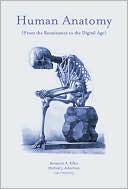Memento Mori. (20)

Human Anatomy: From the Renaissance to the Digital Age by Rifkin, Ackerman & Folkenberg.
"The Necromancer's
been an invaluable help!"
- Leo da Vinci
I was pretty proud of myself while I read this. I had seen a copy on Nino's shelf about a year ago, & was filled with a great & overwhelming envy & lust. I ordered it from Kit Marlowe & Co. & then promptly forgot about it. Well, I got it the other day, & after wiping the drool from my chin (it really is very pretty) I dug in. What we've got here is an exploration of the art of human anatomy illustration, more than a primer on human anatomy proper-- a bit meta. It starts with Vesalius, who is entirely awesome & goes up through Gray's anatomy, which was printed with woodblocks & published in 1858 (297)! Well, a little past that, closing with Braune & a discussion of CT & MRI imaging. The first bit of it is the bulk of the text; a little historical perspective! Then into the artists & their work-- & it isn't until the end that anyone talks about the difference between accurate & useful in terms of "truth" (325). Like, there is some connotation towards it, including the x-ray's paired with illustration, but it isn't said out loud for a long while (322). I mean, a whole mess of goo & flesh isn't hardly helpful in trying to understand anatomy, right?
On the rundown-- Da Vinci did the drawing used in the homonculus I was talked about (11). Also, Death saying "et in Arcadia ego" is awesome, but I prefer "et in Paradisio ego" (23). There is a Saint Bartholomew-esque flayed man holding his skin by Juan Valverde de Amusco who is super awesome, though I guess the word for "flayed" is "Écorché," & speaking of there is an awesomely titled illustration of a dissected back by Jacques Fabian called "Flayed Angel" which is pretty metal (29, 61, 57). In a similar poetic (or I guess I should say Romantic) vein the winged skellington motif is something I'm a fan of (38, 220). I also liked Casseri & Spieghel's dressing the anatomical models as the four seasons to outline the chronology of the dissection of the reproductive system, especially Ceres' diadem of wheat & the talk about "Winter" as a naked figure shivering under a veil (123, 33). There is a neat illustration of the dissection workbench, too (81). Oh & the guts as armor-- that would be an awesome magic item to give out (99). The very phallic illustration of a vagina is...disturbing (101). On the other hand, the skeleton morphing into a pillar is super elegant (111). I think on the balance, that the unfortunately named William Smellie is my favorite, because his illustrations transcend the page to be lifelike enough to seen truly gruesome, & the same for his contemporary Hunter (195- 209, 210-217).